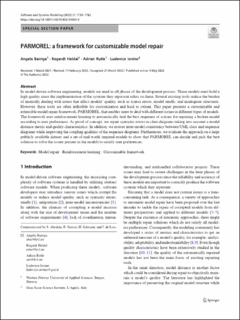| dc.contributor.author | Barriga Rodriguez, Angela | |
| dc.contributor.author | Heldal, Rogardt | |
| dc.contributor.author | Rutle, Adrian | |
| dc.contributor.author | Iovino, Ludovico | |
| dc.date.accessioned | 2023-03-27T05:32:19Z | |
| dc.date.available | 2023-03-27T05:32:19Z | |
| dc.date.created | 2022-10-10T10:24:45Z | |
| dc.date.issued | 2022 | |
| dc.identifier.citation | Software and Systems Modeling (SoSyM). 2022, 21 1739-1762. | en_US |
| dc.identifier.issn | 1619-1366 | |
| dc.identifier.uri | https://hdl.handle.net/11250/3060448 | |
| dc.description.abstract | In model-driven software engineering, models are used in all phases of the development process. These models must hold a high quality since the implementation of the systems they represent relies on them. Several existing tools reduce the burden of manually dealing with issues that affect models’ quality, such as syntax errors, model smells, and inadequate structures. However, these tools are often inflexible for customization and hard to extend. This paper presents a customizable and extensible model repair framework, PARMOREL, that enables users to deal with different issues in different types of models. The framework uses reinforcement learning to automatically find the best sequence of actions for repairing a broken model according to user preferences. As proof of concept, we repair syntactic errors in class diagrams taking into account a model distance metric and quality characteristics. In addition, we restore inter-model consistency between UML class and sequence diagrams while improving the coupling qualities of the sequence diagrams. Furthermore, we evaluate the approach on a large publicly available dataset and a set of real-world inspired models to show that PARMOREL can decide and pick the best solution to solve the issues present in the models to satisfy user preferences. | en_US |
| dc.language.iso | eng | en_US |
| dc.publisher | Springer | en_US |
| dc.rights | Navngivelse 4.0 Internasjonal | * |
| dc.rights.uri | http://creativecommons.org/licenses/by/4.0/deed.no | * |
| dc.title | PARMOREL: a framework for customizable model repair | en_US |
| dc.type | Peer reviewed | en_US |
| dc.type | Journal article | en_US |
| dc.description.version | publishedVersion | en_US |
| dc.rights.holder | © The Author(s) 2022 | en_US |
| dc.source.pagenumber | 1739-1762 | en_US |
| dc.source.volume | 21 | en_US |
| dc.source.journal | Software and Systems Modeling (SoSyM) | en_US |
| dc.identifier.doi | 10.1007/s10270-022-01005-0 | |
| dc.identifier.cristin | 2059955 | |
| cristin.ispublished | true | |
| cristin.fulltext | original | |
| cristin.qualitycode | 2 | |

